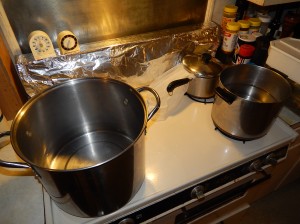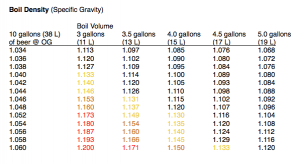
You can make 5 gallons (19 L) of beer by boiling wort on your stovetop, but what about 10 gallons (38 L)?
Typical homebrewing practice for stovetop extract brewers is to boil a few gallons (perhaps 8–11 L) of wort and dilute it to 5.0 gallons (19 L) in the fermenter. But if what if you wanted more beer? Could you boil a thicker wort and dilute it to 10 gallons (38 L)? In some cases, this might be possible. To understand when this might be possible, let’s look at the numbers associated with attempting this. Specifically, let’s look at the wort densities, bitterness levels, and wort colors that would result for trying this.
This Could Work (in Limited Situations)
If you could dilute a few gallons (11 L) of wort to 10 gallons (38 L) and make good beer, wouldn’t everyone be doing it, at least every once in a while? The time spent making 5 gallons (19 L) of beer could yield 10 gallons (38 L). As we’ll see, there are good reasons why this would yield substandard beer for most beer styles. However, there are perhaps a few types of beer that could be brewed this way — and I’ll give away the punchline by saying that the beer would have to be low gravity, not very bitter, and amber or darker. Here’s why.
Wort Density
Let’s say you were trying to brew an IPA at OG 1.060. You wanted to boil 2.5 gallons (9.5 L) and dilute it to 10 gallons (38 L) in two carboys. Would this work? Almost assuredly not. In order to do this, the OG of your wort would need to be 1.240 — about twice as dense as very strong barleywine wort. (In addition, you’d have to squeeze enough hops for 10 gallons (38 L) of beer into 2.5 gallons (9.5 L) of wort, but we’ll discuss that later.)
In order to calculate your required boil density, use the concentration times volume (CV = CV) formula. Take the target concentration (in either °Plato or “gravity points”) of your desired wort times the desired volume (in gallons or L) and divide by your intended boil volume. (In our example, we wanted 10 gallons of wort at an OG of 1.060. SG 1.060 is 60 gravity points, so 60 GP (10 gallons)/2.5 gallons= 240 GP, or a specific gravity of 1.240.)
On the other hand, what if you wanted to brew a low gravity session beer, around OG 1.040, and you planned to boil 3.5 gallons (13 L) of wort? (Either you boiled a larger volume down to 3.5 gallons (13 L), or you boiled 3.5 gallons (13 L) and kept the boil topped up with boiling water.) In that case, the boil gravity would be 1.114 — this is high, but within the range of a strong barleywine and therefore presumably doable.

Click on chart to expand. Boil density (the numbers within the table), based on 10 gallons (38 L) of beer at various specific original gravities (OG) and boil volumes.
The chart along with this article shows what your boil gravity would need to be to produce 10 gallons (38 L) of beer from various volumes of wort. These are in the range that could possibly be boiled on a stovetop. In the chart, I list wort densities below 1.130 in black, because I’ve brewed all-grain beers up to (and slightly over) that density. (Most of the monster big beers I’ve brewed, such as Krampus Klaws, had sugar as a kettle adjunct.) Above that, I’ve put the numbers in various colors, indicating increasing caution as yellow changes to orange and then red. However, if you’re interested, you can try pushing the limits.
If the specific gravity of the boil were the only consideration, and we held the boil gravity under 1.130, quite a few low-gravity BJCP styles could be brewed this way. But beer contains hops as well as malt, so let’s look at bitterness.
Bitterness and Maximum IBUs
As wort density increases, we all know that you need to add more hops to yield the same degree of bitterness (in IBUs). A bigger problem for trying to yield 10 gallons (38 L) of beer from a stovetop wort is the dilution factor. In our example above, for a 70-IBU IPA, our 2.5 gallons (9.5 L) of wort would need to contain 280 IBUs. (Use the same CV = CV formula for calculating this, with C being IBUs.) In theory, the maximum amount of IBUs you can get from boiling hops is 70–100 IBUs (sources differ). If we take 100 IBUs as the maximum, this “IPA” would only have 25 IBUs. (2.5 gallons of wort at 100 IBUs converts to 25 IBUs when the wort is diluted to 10 gallons.)
A little math — the CV formula once again — shows us that we could have achieved 30 IBUs if we boiled 3.0 gallons (11 L); we could have achieved 35 IBUs if we boiled 3.5 gallons (13 L) and we could have achieved 40 IBUs if we boiled 4.0 gallons (15 L). [This assumes you’ve hopped to saturation, then diluted to 10 gallons (38 L).] You’d still have to add a fair amount of hops to a small amount of wort to get there, but it would be possible. If the maximum level of IBUs is really 70, for 3.0 gallons (11 L), 3.5 gallons (13 L) and 4.0 gallons (15 L) of boiled wort, the bitterness in 10 gallons (38 L) of wort would be 21, 24.5 and 28 IBUs, respectively,
So, once you figure in bitterness, the number of BJCP styles you could brew this way drops, but you could still brew anything under the above limits associated with their boil volumes.
In part 2 of this article, I’ll discuss wort color, brewing tips and beer styles that you could brew with this method.

Speak Your Mind